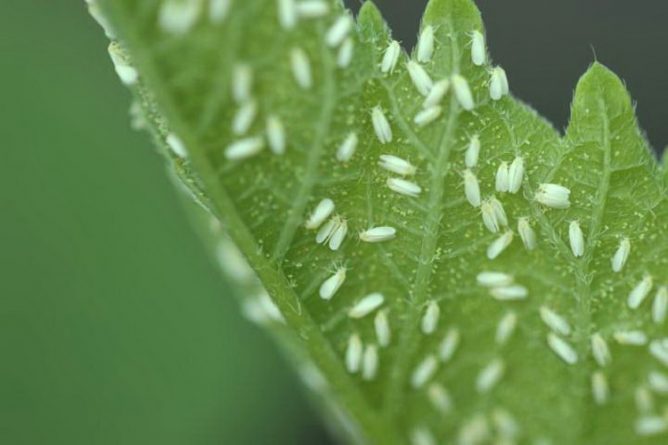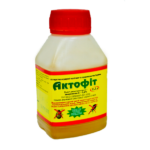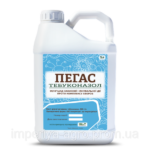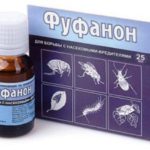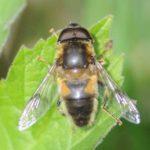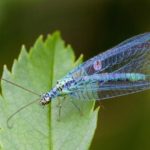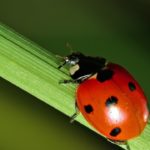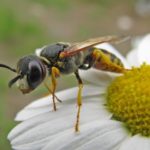It's nice to pick a tomato yourself grown from the garden, just eat it or cook something tasty and healthy. But it becomes insulting to tears, when the crop is spoiled by pests. It looks like small, but far from harmless, white midges, they drink life-giving juices from the plant, they multiply, but they have control. In this article, we will learn how and how you can deal with these tomato flies, and whether you can get rid of them forever.
Table of contents
Harmful whitefly on tomatoes
Most of the insects parasitizing on tomatoes belong to the dangerous kind of aphid species. It spreads the disease through viruses, causes anomalies in plants. This attack can be overtaken during the summer season, especially during the growing season and fruit ripening.
High fertility leads to the fact that the leaves are completely plastered with it. More often, a black and black fly settles on the tomatoes. The first is called the whitefly, the second winged aphid in the folk - cicadka.
If on the lower part of the leaves appeared bright bloom, resembling flour, then it is the whitefly. Body size not more than 3 mm, has 4 porches. It jumps well, flies, easily moves around the site or the greenhouse. Adult feces cause damage to the lower parts of plants, more than they eat. Emerging from their larvae, the caterpillars secrete a waxy substance, which firmly sticks the parasite to the plant. The insect sticks to the plate, drinks juices, the reserves of which are enough for the development of the pupa, while the planting perishes.

To determine the presence of the parasite is also possible by:
- twisted leaves;
- yellowed parts of the plant;
- uneven ripening fruits;
- white streaks inside the tomato.
Black fencer and the reasons for its occurrence in seedlings
There is a black small midge with wings and without them. Its life cycle depends on the presence of ants on the farm. Ant nests serve as a home for them at night, and there they can lay eggs. They do not have a good flight ability, but when danger is present, they quickly move to neighboring bushes and form mass clusters. They feed, like whiteflies, with nutritious juices, often affect the inner side of the leaves.
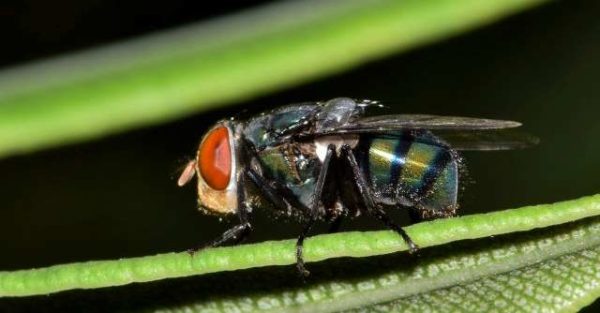
The reasons for the appearance of both are similar:
- heat, high humidity, no wind;
- planting density, both in greenhouses and on open ground;
- application of untested fertilizers, incl. contaminated manure;
- planting seedlings infected by pest larvae.
With the above climatic factors, white and black insects can spread to all cultures over the summer. Pests live up to 25 days, i.e. during the warm season is replaced by several generations.
How to deal with white and black tomato gnats?
Some gardeners are trying to deal with small formations of pests with a hose, washing them with water, or destroy their hands. Such manipulations are ineffective. Rather help:
- Fumigation method. It is held in greenhouses at least 2 times a year. Evaporation, stagnant air, heat in them are an excellent environment for midges and the formation of soot fungi. Sulfur candles will help. Pre-tomatoes better temporarily carry away.
- Chemical attack. It is carried out by soft pesticidal, organic insecticides with an abundance of insects. Safer products will be on pyrethrins, fatty acids, plant esters. Against mosquitoes are popular: "Aktafit", "Fufanon", "Pegasus". Gardening shops offer many options. Strictly according to the enclosed instructions solutions are prepared. Tomatoes are processed 3 times every 5 days. There are single-use drugs. It is necessary to carefully study the composition and rules of working with them.
- Aktafit
- Pegasus
- Fufanon
Methods of destruction flies proven over the years
It would be preferable to give the first place to the folk methods of dealing with the whitefly or the black cicadas. It is necessary to start chemical processing when they did not help. The main enemies of midges are soap and vinegar (alkali, acid). Prepare solutions with them:
- take 2 tbsp.spoons of liquid soap, dissolved with 0.5 liters of water, add sunflower oil;
- 10 g of soap, diluted in 10 liters of warm water with a glass of ash;
- 1 tbsp. spoon 9% vinegar per liter.
Does not like aphids and individuals of its varieties of hot peppers, garlic, mustard. 200 g of minced garlic are infused in a bucket of water, stirring. Before use, pour 50 g of dry mustard and 20 hot red pepper. Onion peel will also help. It is boiled for half an hour, the solution should have a high concentration: 300 g per small bucket.

Handle such feeds twice: in the morning and in the evening.
Preventive measures to save tomatoes from parasites
Fighting a white or black gnaw can ruin the entire summer season. It is simpler and more humane for the plant to prevent the spread of unexpected guests. The whitefly, cicadas, like all parasites, do not like the cold. Elementary airing of the greenhouse in the winter time to get rid of their appearance.
It is worth trying a biological method, which is concluded in attracting insects that eat midge larvae. Provident gardeners planted fragrant herbs next to tomato seedlings, they attract:
- ladybugs;
- wasps, bees;
- gold-eyed;
- wobblers.
- Hotshot
- Gold-eyed
- ladybug
- Bees
White and black midges do not tolerate the smell of calendula, dill, onion, garlic.
The excreted sweet liquid attracts ants to harmful insects. The presence of trails near the beds indicates their presence. Therefore, it is also necessary to get rid of anthills, because eggs are stored there.
To grow tomatoes healthy, you should not plant them thickly, even if there is little land. When plants are next to each other, there is a lack of light, nutrients in the soil. Shoots weaken, and the whitefly does not sleep. She finishes the crop, ruins the crop. Therefore, do not make a close landing. It is preferable that there are fewer large whole tomatoes than a greater number of painful fruits from one site.
